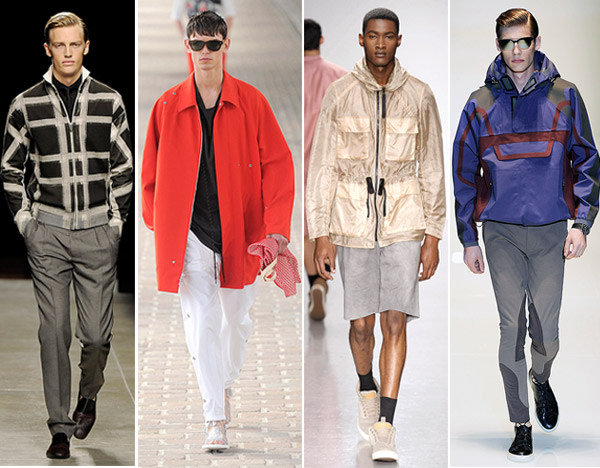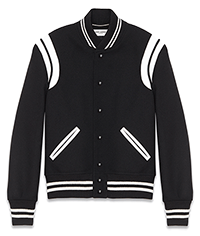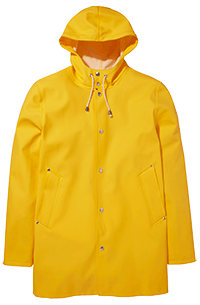A fresh coat: men’s spring jackets

Roula Khalaf, Editor of the FT, selects her favourite stories in this weekly newsletter.
It’s spring, which means that a young (or even not so young) man’s fancy turns to light jackets. Only recently, many men would have invested in one good winter coat and braved the change of seasons with merely a scarf and gloves to supplement an office suit jacket – or maybe just a trench for April showers. Not any more. But with bomber jackets, trench coats, field coats, peacoats, parkas, performance jackets and more all vying for a spot in the modern man’s wardrobe, what should we look out for?
“If you have to buy just one jacket this season, make it a bomber,” says Toby Bateman, buying director at Mr Porter. “There is a real variation in styles within the bomber category, from cotton versions by Hentsch Man [£250] and Gant Rugger [£150] to luxurious silk-lined suede styles from Gucci [£3,210], reversible cashmere-lined windproof jackets by Loro Piana [£1,565] and butter-soft nubuck styles by Bottega Veneta [£3,450].”

Adrian Ward-Rees, director of menswear at Lane Crawford, backs the bomber, too. “The key silhouette in jackets for the next 12 months is the bomber or ‘varsity’ jacket,” he says. “It has been a strong look in most catwalk collections for summer and continues into autumn. The major designer brands for the style are Saint Laurent [leather trim wool twill varsity jacket, £1,040], Lanvin [plaid cotton bomber, £795], Neil Barrett [satin bomber, £1,060] and 3.1 Phillip Lim [cotton blend bomber, £425]. But most of our brands have referenced this silhouette.”
For the most part, the current crop of bombers are based on the classic MA1 flight jacket. The style was developed for US Air Force crews in the late 1940s in high-quality nylon as a lightweight alternative to the original fleece-lined leather “Biggles” jackets of the first world war (these were no longer suited to the higher altitudes flown). Decades later, the same jacket was appropriated by street-style tribes from 1970s skinheads to 1980s clubland hipsters. A regular fixture in magazines the Face and i-D, in its 1980s heyday the MA1 was reimagined by designers such as Jean Paul Gaultier and Katharine Hamnett.
As with all styles with a past, though, if you wore it “back in the day”, is it wise to revisit the same look now?
“I wouldn’t normally advocate wearing an item of clothing that you wore the first time around,” says Gordon Richardson, creative director of Topman, a store that stocks several variations of the bomber style (from £30). “But if bought wisely, the bomber can take years off you – which is no bad thing.”
The bomber may be a popular look for lighter jackets but it is not the only one. “Windcheaters are also one of the key jacket styles this season,” says Bateman. “We’ve seen the trend develop out of the blending of sportswear and street style. Men like technical fabrics and functional designs – they make jackets practical for taking on and off, or packing up in a bag as [the weather] gets warmer.” Indeed, what was once called a cagoule is now not only acceptable outerwear but decidedly cool. Lanvin’s hooded lightweight jackets (£1,375) are a sophisticated take on the windcheater shape, as are pack-away jackets by Christopher Raeburn (£240).
Eleanor Robinson, designer-wear buyer at Selfridges in London, agrees. “Sportswear is a huge influence this season,” she says, citing “colourful 1990s-influenced street shapes at Raf Simons [diagonal colour block blouson, £535] and MSGM [floral printed hooded jacket, £310].”

Those not entirely convinced by a pac-a-mac costing three figures might take comfort in something more structured. “The raincoat is an important and easy-to-wear option,” says Robinson. “A streamlined style works well over summer suiting and is smart enough for the office. New Scandinavian brand Stutterheim offers a classic version [PVC coated rain mac, £200] and Riccardo Tisci’s ‘camo’ style for Givenchy [£1,150] also fuses practicality with an edge.”
Topman’s Richardson says: “A single-breasted three-quarter-length mac is the best choice for wearing over tailoring. The proportions will allow the suit to sit well as anything too cropped will nip in at the waist and distort the suit’s line.”
In New York, Phillip Lim hedged his bets by showing everything from bomber and biker jackets to lightweight summer macs. “There is always a sense of casualness in my clothes,” says Lim. “But this season I wanted to make real pieces for everyday life.” Although he favours a mix of styles, he admits that the summer mac might work best for most men. “I guess the most office-appropriate style in the collection is the classic car coat in a really lightweight fabric [in blue or red, $850] which can be worn over a suit or more casually with jeans and a T-shirt at the weekend.”
The Perfecto-inspired biker style has become ubiquitous over the past few years. “Bomber jackets are a great day-to-day piece but I still strongly feel the biker is a staple for every man’s wardrobe,” says Raphael Elicha, co-founder of French label The Kooples. “My personal favourite is our biker jacket with leather panels [£295]. It works well with a simple sweater and a pair of skinny trousers or can be worn in the evening with a black shirt and black jeans.”
Yes, biker jackets are still big news but, Toby Bateman warns, “I wouldn’t recommend wearing a traditional leather Perfecto in a corporate working environment. Not unless you have the motorbike to back it up.”
——————————————-
Stockists
More of this week’s Style stockists
Comments